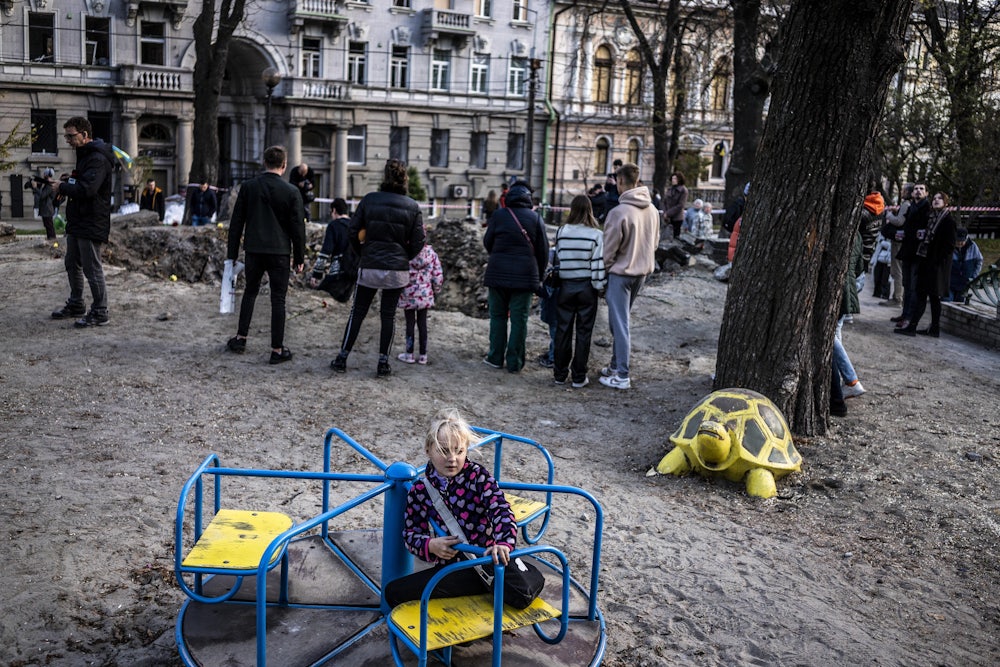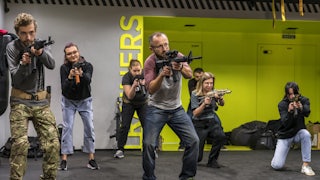When Russia launched missiles this Monday into Kyiv, my home for the last two months, I was nowhere near the scene. Instead, I was out on a reporting trip to a place I’d normally consider much riskier, the eastern Ukrainian city of Kramatorsk. The city lies a little over 30 miles from the front line of where Russian and Ukrainian forces are in active combat, close enough to hear the boom of outgoing Ukrainian artillery and occasionally the crack of incoming Russian fire. Amid journeys defined by bombed-out villages and bone-rattling, shell-pocked roads, I woke up that morning ready for my previous night’s plan of returning to Kyiv.
Scrolling through Twitter, though, I quickly realized that my faith in Kyiv as a relative safe haven was misplaced. For the first time in the war, Russia had attacked Kyiv’s city center. Not only that, it had launched its missiles at a time of day designed to maximize civilian casualties, striking at rush hour in locations known as popular places where the city’s residents gather for everyday life. Other cities in the country had experienced these types of vicious attacks, but Kyiv, especially its historic downtown, had been spared.
Ukrainians are hardly likely to see their fighting spirit diminished by these attacks, despite the terrifying way in which they recall the shock of the first early days of the war. In part, this is because war has become normal. However, it’s also because they have few other choices. Russia’s indiscriminate attack on civilian targets again confirmed what Ukrainians have known from day one of Russia’s first assault on Kyiv in February—war with Russia is not a matter of choice but of life and death.
But for much of the summer and early fall the war felt strangely distant in Kyiv. Air raid sirens, while constant, were often ignored as virtually no missiles landed in Kyiv. It’s unclear how often Russia attempted to target the city, but Ukrainian military officials spoke of Kyiv having well-prepared anti-air defenses capable of handling all but a mass missile attack. Amid urgent U.S. warnings of a massive missile strike in Kyiv in late August, I went and interviewed Ukrainians who had come to the city center to gawk at a display of burned Russian tanks. The wail of an air raid siren sent approximately no one scurrying for cover.
Now my social media was full of Ukrainians taking shelter in the city’s vast underground metro system. A friend staying in my apartment told me that one explosion had been visible from our windows. He had taken my roommate’s cat to shelter in the building’s underground garage.
As I watched the news of the attacks unfold from a café in Kramatorsk, my own personal sense of dread was magnified by how familiar I was with Russia’s targets. In Shevchenko Park, a gorgeous tree-filled square where I’d taken many walks, the maw of an enormous missile crater now gaped next to a playground. In one video I watched over and over, the glass pedestrian bridge that I’d strolled on with my wife suddenly was obscured by the billowing explosion of a missile strike. There were no obvious military or infrastructure targets near the blast sites, making it evident that terror was the sole objective.
We would eventually learn that the strikes had left six dead and almost 50 wounded. Among the dead was a Ukrainian doctor driving to work after dropping her 5-year-old son off at daycare.
Russia’s escalation soon had me and the two journalists with me worrying that the war was about to enter a new, even more dangerous phase. Putin was scheduled to give a speech later that day. Perhaps Belarus, whose border was less than 100 miles from Kyiv, would finally join Russia in the war and send its troops charging toward Kyiv. Mentally, my mind began to shift and rearrange plans—how, I thought, would I get out of the city if I had to?
While I was on the road back from Kramatorsk to Kyiv, Putin announced that the attacks were revenge for Ukraine’s recent bombing of the Kerch bridge, a 12-mile-long structure connecting Russia to Crimea, which Russia illegally annexed from Ukraine in 2014. In a head-scratching twist, Putin labeled the attack on the militarily important bridge as a “terrorist attack” and subsequently ordered the bombing of the exclusively civilian targets in downtown Kyiv.
Nevertheless, to us the speech counted as a form of good news. The missiles didn’t obviously mark a new phase in the war. For now, no tanks would be rolling in from Belarus. Nor, despite near-constant jitters in Kyiv, did Putin announce that Russia would next strike Ukraine with a nuclear missile. Our mood lightened. For the next day or two, it seemed, we could relax.
Kyivans, who lived through Russia’s attempted siege of the city in March and April, have seen worse. When we returned we found that restaurants, gyms, and grocery stores remained full. A car-size crater at an intersection downtown is already filled in, the smooth new asphalt standing in rebuke to the missile strike. Some, like one boxing trainer at my gym, say they’re simply used to the war.
Those at the front, though, explain it differently. On the square of Lyman, a city recently retaken by Ukraine, I met one soldier who dwelled briefly on Ukraine’s battlefield losses. To him, the losses of war were simply the price Russia was making Ukraine pay. “We have no other choice,” he said. “We’ll count our losses after the war.”


